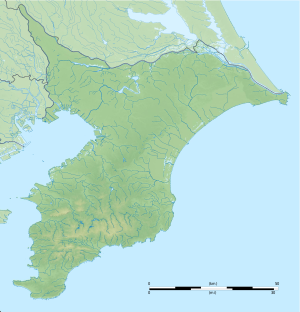Ōtaki Castle
| Ōtaki Castle | ||
|---|---|---|
|
Ōtaki, castle tower |
||
| Creation time : | 1590 | |
| Castle type : | Hirayamajiro (hill castle) | |
| Conservation status: | Partly reconstructed | |
| Place: | Ōtaki | |
| Geographical location | 35 ° 17 '9.2 " N , 140 ° 14' 21.6" E | |
|
|
||
The Ōtaki Castle ( Japanese 大多 喜 城 , Ōtaki-jō ) is located in the city of Ōtaki in Chiba Prefecture . In the Edo period , the Ōkōchi last resided there as Fudai daimyō .
Lords of the castle in the Edo period
- From 1601 a show of the Honda with an income of 50,000 Koku ,
- from 1617 the main branch of the Abe with 30,000 koku,
- from 1623 a branch of the Aoyama with 20,000 koku,
- from 1638 a side branch of the Abe with 10,000 koku,
- from 1671 a side branch of the Abe with 16,000 koku,
- from 1702 the main branch of the Inagaki with 25,000 Koku,
- from 1703 a branch of Ōkōchi with 20,000 koku.
history
In 1590, Tokugawa Ieyasu's important vassal , Honda Tadakatsu with an income of 100,000 koku, built a new castle in Shimousa Province, southwest of the old Burgtakinekoya ( 大多 喜 根 古屋 城 ) castle. When Tadakatsu was transferred to Kuwana in 1601, his younger brother Tadatomo ( 忠 朝 ; 1582–1615) took over the castle.
When the Portuguese missionary João Rodrigues stranded on the Pacific side of the Chiba coast on the way to Mexico in 1609 shortly after his departure, he and his entourage were received by Tadatomo at the castle. Rodrigues describes in his book about Japan, História da Igreja no Japão , the castle as well laid out and the residence as adorned with gold and silver.
After the Honda were transferred, the Abe, Aoyama, Inagaki received the castle, until finally a branch of the Ōkōchi took over the castle and lived there until the Meiji Restoration .
investment
The castle is located northwest on a hill, which is flowed around by the Izumi River ( 夷 隅 川 ), with the innermost castle area, the Hommaru ( 本 丸 ), being laid out on the highest point. One level lower was the second area, the Ni-no-maru ( 二 丸 ) and even further down the third area, the San-no-maru ( 三 の 丸 ). In the second area were the residence and the residences of the most important vassals, in the third area the residences of further vassals as well as the stores for rice and gun powder. On the west side the Hommaru was protected by the outer bailey Tsume-no-maru ( 詰 の 丸 ).
In 1699, on the orders of Bakufu, the castle was modernized and the entire complex was reduced in size. It had to do with the fact that lower-ranking daimyo were lords of the castle. In 1842, when Matsudaira (Ōkōchi) Masatomo ( 松 平正 和 ; 1823–1862) was lord of the castle, the castle tower and the residence were lost in a fire. Only the residence was later rebuilt.
Today there is again a reconstructed castle tower that serves as a museum and is part of the Central Chiba Prefecture Museum ( 千葉 県 立 中央 博物館 , Chiba kenritsu chūō hakubutsukan ). The Ōtaki high school is located in Ni-no-maru, while San-no-maru has become a residential area. The Yakui Gate, the large fountain on the former residence site and part of the ramparts and dry moats have been preserved.
photos
Remarks
- ↑ The yakui gate ( 薬 医 門 , yakuimon) is a certain type of gate.
literature
- Sugai, Yasuo: Ōtaki-jo in: Miura, Masayuki (ed.): Shiro to jinya. Tokoku-hen. Gakken, 2006. ISBN 978-4-05-604378-5 , p. 80.
- Nishigaya, Yasuhiro (Ed.): Ōtaki-jo. In: Nihon meijo zukan, Rikogaku-sha, 1993. ISBN 4-8445-3017-8 .




